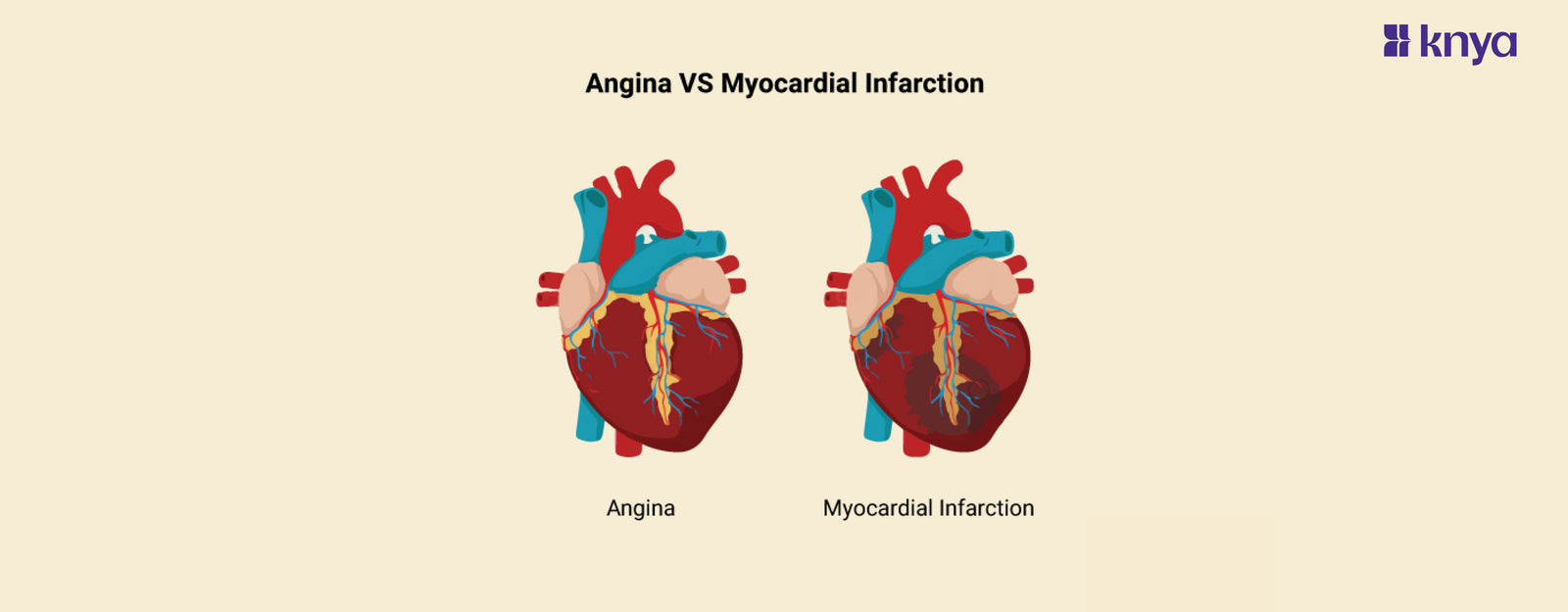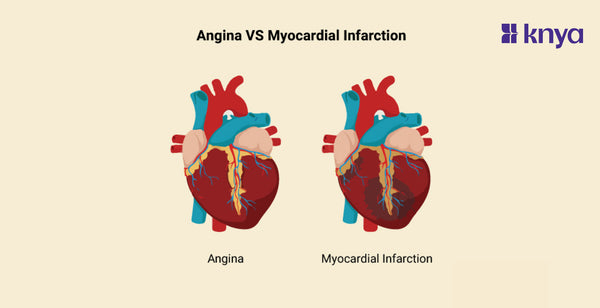Difference Between Angina and Myocardial Infarction: Angina and myocardial infarction (heart attack) are both caused by coronary artery disease, however they differ significantly. Angina is a warning sign, indicating a temporary obstruction limiting blood flow to the heart, resulting in chest pain that can be eased by rest or treatment. Myocardial infarction, on the other hand, refers to a significant blockage that causes continuous loss of blood flow, resulting in heart muscle damage and the need for rapid medical intervention. Recognising the difference is critical, since Angina requires lifestyle modifications and maybe medication to control the underlying issue, whereas a heart attack demands rapid care to minimise damage. So, Angina vs myocardial Infarction indicates a range of severity, requiring fast treatment if you experience either to protect your heart health. Remember, any persistent chest discomfort requires emergency medical attention.
Difference between Angina and Myocardial Infarction
Angina and myocardial infarction (MI) are both cardiovascular conditions, but they differ in terms of their causes, symptoms, severity, and implications. Highlighting the differences between angina and myocardial infarction.
|
Feature |
Angina |
Myocardial Infarction (MI) |
|
Definition |
Chest pain or discomfort due to insufficient blood flow and oxygen to the heart. |
Result of a complete blockage of blood flow to a part of the heart muscle, causing tissue damage. |
|
Cause |
Temporary reductions in blood flow, often due to narrowed coronary arteries. |
Prolonged and complete blockage of blood flow, usually caused by a blood clot. |
|
Duration |
Temporary, subsiding with rest or medication. |
May result in permanent tissue damage. |
|
Severity |
Generally less severe than a heart attack. |
Represents a more serious and potentially life-threatening condition. |
|
EKG Changes |
Transient changes may not show significant abnormalities. |
Persistent and significant EKG abnormalities, such as ST-segment elevation. |
|
Risk of Death |
Usually not life-threatening. |
Can be life-threatening if not treated promptly. |
|
Tissue Damage |
Does not cause permanent damage to the heart muscle. |
Results in irreversible damage to the affected part of the heart muscle. |
|
Treatment |
Managed with medications and lifestyle modifications. |
Emergency treatment with medications, angioplasty, or bypass surgery may be necessary. |
|
Pain Characteristics |
Described as pressure, squeezing, or burning sensation. |
More intense and prolonged pain, described as crushing or stabbing. |
|
Frequency |
Recurrent episodes, triggered by exertion or stress. |
Generally a one-time event, though there's an increased risk for future events. |
|
Cardiac Origin |
Originates from the heart. |
Also originates from the heart. |
Browse Best Scrubs Collection
What is Angina?
A brief warning sign of insufficient blood flow to the heart, is commonly seen as chest pressure, pain, or tightness. It is frequently caused by effort or stress and is treated with rest or medicine. While painful, it does not cause permanent harm.
Key Features of Angina:
- The hallmark symptom is chest pain, described as tightness, pressure, squeezing, or burning, typically originating behind the breastbone and radiating to the jaw, left arm, neck, or back.
- Pain typically lasts from minutes to 20 minutes, subsiding with rest or medication (nitroglycerin). Prolonged pain (over 30 minutes) raises concerns for MI.
- Often triggered by exertion, emotional stress, cold weather, heavy meals, or smoking. It resolves when the trigger subsides or blood flow improves.
- Temporary insufficient blood flow due to narrowed coronary arteries (atherosclerosis), but heart muscle damage is minimal or absent.
Explore All Women's Scrub
What is Myocardial Infarction?
A dangerous incident in which a prolonged blockage in a coronary artery prevents blood flow, resulting in heart muscle death. Symptoms are comparable to angina, except they are usually more severe, persist longer, and cannot be eased by rest or medicine. This can result in irreversible myocardial damage, necessitating rapid medical intervention.
Key Features of Myocardial Infarction:
- Similar to angina, but often more severe, prolonged (over 30 minutes), and unresponsive to rest or nitroglycerin. May be accompanied by crushing, burning, or aching pain.
- Pain can persist for hours or days, potentially radiating to other areas and accompanied by sweating, nausea, lightheadedness, and shortness of breath.
- Similar to angina, but may occur at rest or with minimal exertion.
- Prolonged blockage of a coronary artery, leading to significant heart muscle damage or death (necrosis). Requires immediate medical attention.
Similarities Between Angina and Myocardial Infarction
- Cardiac Origin: Both angina and myocardial infarction are cardiovascular conditions originating from the heart.
- Symptoms: Both can present with symptoms like chest pain, discomfort, and shortness of breath.
- Risk Factors: Shared risk factors include hypertension, diabetes, smoking, high cholesterol, and family history of cardiovascular disease.
- Diagnostic Tests: Both conditions may be diagnosed using similar diagnostic tests, such as EKG, stress tests, and cardiac imaging.
- Treatment Goals: The overall goal in managing both angina and myocardial infarction is to improve blood flow to the heart and prevent further complications.
While both Angina and Myocardial Infarction (heart attack) are caused by restricted blood flow to the heart owing to constricted arteries, the severity and long-term consequences of both conditions differ significantly. Angina, often known as chest pain or pressure, serves as a warning indication of a transient decrease in blood flow. A heart attack, on the other hand, represents a longer-term blockage that, if not addressed swiftly, can result in irreversible myocardial damage. While both have comparable symptoms, such as chest pain, angina usually goes away with rest or medicine, but heart attack pain is generally more acute, long-lasting, and resistant to conventional treatments. Remember, if you are experiencing chest pain, do not hesitate to seek emergency medical help, as prompt treatment can make all the difference.
Order the Best Jogger Scrub from Here!
| Check out More Articles | |
| Difference Between Cartilage and Bone | |
| Difference Between Endocrine and Exocrine Glands | |
| Difference Between Cell Wall and Cell Membrane | |















